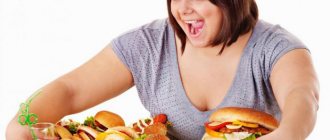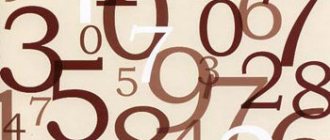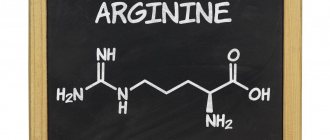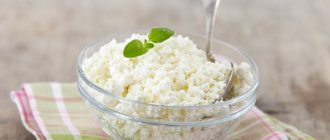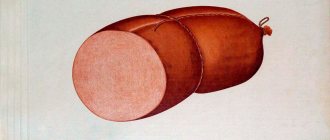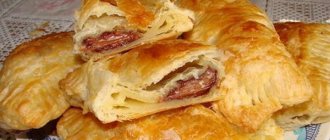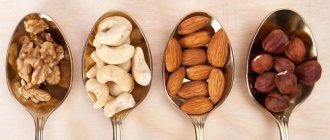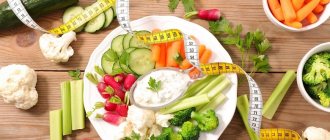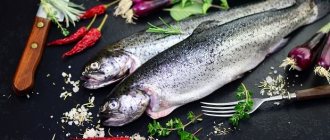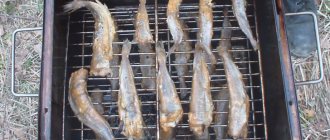Details
Hello dear readers, based on your numerous requests, I have prepared useful and convenient material for you, thanks to which you will be able to determine the weight of products in grams without the help of scales. Using the tables presented, you can, for example, determine how much flour is in a tablespoon or how many grams of sugar are in a glass, or ask how much a liter of honey weighs and other mathematical calculations that are so necessary in the kitchen.
Let me remind you that on our website we have already described a method for determining portions using the palm of your hand. If you have not seen this article yet, be sure to check it out.
Article in addition to this topic:
The method of determining portions using the palm of your hand is simply a godsend, which is an indispensable useful cheat sheet not only during your weight loss, but throughout your life. After all, overeating is one of the main causes of excess weight.
In preparing dietary recipes, kitchen scales are most often used, but for some this is a burdensome task. For such people, I offer an excellent alternative. When preparing a diet menu, use volumetric measures of products, namely a glass and a teaspoon or tablespoon; for larger volumes, a liter jar. And the first table I will present is a table of the relationship between the measures of products.
Table of weights and measures: what and how to measure if you don’t have a measuring cup
Experienced housewives rarely use a measuring cup or kitchen scale in the kitchen, since they do everything by eye.
However, some complex dishes require perfect proportions, such as baked goods and desserts. In this case, you can use an ordinary glass or spoon, as our mothers and grandmothers once did. And, by the way, they made the thinnest lacy pancakes, ruddy pies, crumbly cookies and perfectly baked tender biscuits, which were eaten very quickly. Measures for measuring weight at home are simple - a thin and faceted glass, a teaspoon and a tablespoon. Let's talk about how many products fit in these containers.
How to use home weights correctly? For liquid products, containers should be filled to the limit, that is, to the very brim. It is more convenient to apply viscous and thick mixtures (honey, jam, sour cream) with a spoon, making sure that the glass is completely filled. Fill containers with loose and viscous products with a heap, and do not scoop flour and starch directly from a bag or bag, but pour it with a spoon so that voids do not form.
There is no need to shake, loosen or compact the food, and if you need to sift the flour, do it after measuring. The fact is that when sifting, the flour becomes more voluminous, which means its weight will change. For comparison, a thin glass contains 160g of flour when filled correctly, 210g of tamped flour and 125g of sifted flour.
Table of the ratio of the measures of products to each other.
| 1 teaspoon | = | 5 ml |
| 1 tablespoon | = | 15 ml |
| 1 tablespoon | = | 3 teaspoons (i.e. = 15 ml) |
| 4 tablespoons | = | 60 ml |
| 5 tbsp. spoons 1 teaspoon | = | 80 ml |
| 8 tablespoons | = | ½ cup = 125 ml |
| 1 glass | = | 250 ml |
| 4 glasses | = | 1000 ml = 1 liter |
| pinch | = | less than ⅛ teaspoon = less than 1 ml |
How to measure the mass of bulk products without scales
The measure of weight in a glass depends on whether you use a thin glass or a cut glass, as they are different from each other. The faceted glass has a volume of 200 ml, several edges and a rounded rim. The thin glass is absolutely smooth and holds 250 ml. Liquids (water, wine, milk, juice, cream) are easy to measure, but bulk products with the same volume have different weights, which greatly complicates the measurement process.
When comparing products, we will indicate the quantity in a faceted glass (first number) and a thin glass (second number). For example, one glass holds 140–175 g of wheat flour, 180–220 g of granulated sugar, 190–230 g of vegetable oil, 185–240 g of melted butter, 250–300 g of condensed milk and 270–330 g of jam.
As for cereals, you can pour 70–90 g of rolled oats, 170–210 g of buckwheat, 150–200 g of semolina, 190–230 g of rice, peas, beans, millet, pearl barley, barley and small pasta into a glass. This will fit 130–140 g of crushed nuts, 130–160 whole almonds and hazelnuts, 265–325 g of honey, 210–250 g of sour cream, 250–300 g of tomato paste and 100–125 g of ground crackers.
To prepare a delicious dish, you must adhere to certain proportions specified in the recipe. It is not always possible to measure volume or mass on a kitchen scale.
The weight of a product is determined by:
- A tablespoon and a teaspoon.
- A faceted or thin glass.
- Pots of known capacity.
To measure volume correctly, you need to know some tricks:
- When measuring flowability in a glass, fill it no higher than the rim.
- The measuring container is filled to the brim with liquid.
- Dry or viscous bulk products are scooped into a heaped spoon.
- Shaking or trampling the ingredients is prohibited.
- Cereals are measured only in dry form.
- Fresh meat and fish products are not washed before weighing.
- If meat or fish without bones and skin is used to prepare a dish, the net weight is weighed.
- This applies to vegetables and fruits.
- When the specified volume of a dish consists of several ingredients, the components are first prepared and then weighed.
We invite you to read How to make an unfading rose
If you don’t have a liter saucepan at home, you can make a measuring container yourself, use a simple method:
- Prepare two dry pans of different sizes.
- Pour a kilogram of bulk powder into the smaller one.
- Fill the larger container with water and place the smaller one in it.
- The resulting water level is equal to a kilogram of flowability.
In the future, this container is used as a measuring container when determining the mass of bulk products.
To measure liquid ingredients, especially if the volume is in milligrams, it is recommended to use a measuring cup.
Viscous products
Viscous ingredients weigh more than bulk ingredients, since they contain a lot of liquid, pectin, and sometimes sugar. The weight of these products may be slightly or significantly greater, so do not neglect the measurement. After all, if, for example, you put less sour cream or tomato paste in a dish, the dish may not turn out well. Below is a table with the most common viscous products and their weight in a faceted glass.
| Product | Weight to rim (g) | Weight to top edge (g) |
| Sour cream | 220 | 250 |
| Tomato paste | 180 | 220 |
| Mayonnaise | 200 | 250 |
| Condensed milk | 250 | 300 |
| Boiled condensed milk | 280 | 350 |
| Liquid honey | 330 | 415 |
| Jam | 290 | 310 |
| Puree | 290 | 350 |
When calculating the mass of viscous ingredients in a glass, temperature plays a huge role. They are easier to pour when warm or even hot, so it is recommended to heat many products first and then measure their mass.
Liquids
| Liquid product | Product weight in grams | ||||||
| Teaspoon (5 ml) | Dessert spoon (10 ml) | Tablespoon (15 ml) | 200 ml | 250 ml | 500 ml | 1000 ml | |
| Water | 5 | 10 | 15 | 200 | 250 | 500 | 1000 |
| Milk | |||||||
| Cream | |||||||
| Liquor | |||||||
| Cognac | |||||||
| Vinegar | |||||||
| Ghee | 7 | 14 | 20 | 195 | 240 | 480 | 960 |
| Rendered fat | 5 | 10 | 15 | 195 | 240 | 480 | 960 |
| Vegetable oil | 6 | 12 | 18 | 185 | 230 | 460 | 920 |
| Melted margarine | 5 | 10 | 15 | 180 | 225 | 450 | 900 |
Next, I present to your attention a table for measuring and calculating liquid using spoons. See the example for how to use this table?
How to measure 60 ml of milk? We will find the required volume - 30 ml - in the second column. Let's see how many spoons of milk you need to take to measure out 60 ml. And this turns out to be four tablespoons or twelve teaspoons. Suppose you need to measure out 20 ml of wine? We turn to the table, find the second column, there are no numbers 20!
| cup | volume, ml | tablespoon, pcs. | teaspoon, pcs. |
| 1 | 240 | 16 | 48 |
| ¾ | 180 | 12 | 36 |
| ⅔ | 160 | 11 | 32 |
| ½ | 120 | 8 | 24 |
| ⅓ | 80 | 5 | 16 |
| ¼ | 60 | 4 | 12 |
| ⅛ | 30 | 2 | 6 |
| 15 | 1 | 3 | |
| 5 | 1 |
To learn how to measure products more accurately, you need to understand the basic principle of “mass and measures of products by category.” Liquid and bulk products are measured in glasses and spoons, and vegetables, fruits, and root vegetables have their average weight and are measured individually.
Next, I present to your attention a convenient measuring chart of products. Use useful health cheat sheets and prepare dietary dishes exactly according to the recipe.
Faceted glass capacity
Before we begin to describe the capacity of a faceted glass, we need to define what a faceted glass is. What it is? A standard faceted glass is a container 10.5 cm high. The diameter of the bottom of the faceted glass is approximately 5.5 cm, the top edge is 7.3 cm. The height of the top edge (edge) or rim is 1.4 cm. This is what a simple faceted glass looks like . The container is not even, with edges across the entire glass 1.6-2 cm wide, which is why the container got its name.
The measure of a glass with edges is 200 ml to the top edge. If you count with the edge, then 250 ml. On the market you can also find faceted containers with a volume of 50, 75, 150 ml, but it is the 200 ml glass without or with an edge that is the standard. It is in such containers that the weight of the components of different recipes is indicated.
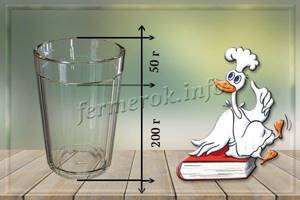
Glass measure with edges - 200 ml to the top edge, with edge - 250 ml
Important!
In the case where a faceted glass has no top edge at all, its capacity up to the top is exactly 200 ml (if we talk about standard sizes).
If the glass is not the typical shape, has defects, or simply looks different and you have doubts about its capacity, you can check it.
- First you need to put an empty glass on the scale, the volume of which needs to be checked. You can write down the resulting number so as not to forget.
- After the first measurement, you need to fill the glass with water (if there is a rim, then water is poured before it) and weigh it again.
- If the glass has a rim, then the third weighing is carried out by pouring water to the very top.
Now the weight of water is calculated by subtracting the weight of the empty glass from the weight of the container with water. This will be the mass of water in ml that fits in this glass. And the obtained values should be written down so as not to forget.
Measuring table for flour, cereals, flakes (content in grams)
| The product's name | Glass /250 ml/ (faceted glass to the brim) | Tablespoon | Tea spoon |
| Wheat flour | 160 | 30 | 10 |
| Potato flour | 200 | 30 | 10 |
| Semolina | 200 | 20 | 8 |
| Buckwheat groats | 210 | 25 | 8 |
| Rice cereal | 230 | 25 | 8 |
| Pearl barley | 230 | 25 | 8 |
| Barley groats | 230 | 25 | 8 |
| Millet cereal | 220 | 25 | 8 |
| Beans | 220 | 30 | 10 |
| Cornflakes | 50 | 17 | 2 |
| Cereals | 100 | 14 | 4 |
| Wheat flakes | 60 | 9 | 2 |
| Potato starch | 230 | ||
| Corn flour | 160 | 30 | 10 |
| Ground crackers | 125 | 15 | 5 |
| Oatmeal | 140 | — | — |
Attention: do not compact the glass after filling it. When compacted, the weight in grams will increase significantly!
Table of measures and weights of food products.
Flour and cereals
| Flour and cereals |
| PRODUCT | TEA SPOON, g | TABLE SPOON, g | GLASS, 200 ml | GLASS, 250 ml |
| Wheat flour | 5-10 | 15-30 | 130 | 160 |
| Potato flour | 6-12 | 16-35 | 150 | 200 |
| Semolina | 4 | 16 | 150 | 200 |
| Pearl barley | 5-6 | 20-24 | 200 | 230 |
| Millet groats | 5 | 20 | 190 | 225 |
| Buckwheat | 5 | 20 | 170 | 210 |
| Wheat groats | 5 | 20 | 190 | 225 |
| Barley groats | 5 | 20 | 190 | 225 |
| Oatmeal | 5 | 18 | 130 | 170 |
| Oatmeal | 6 | 22 | 110 | 140 |
| Oatmeal - rolled oats | 3 | 12 | 70 | 90 |
| Corn grits | 6 | 20 | 145 | 180 |
| Rice | 5 | 20 | 190 | 230 |
| Peas | 5 | 20 | 190 | 230 |
| Lentils | – | – | 190 | 210 |
| Beans | – | 20 | 190 | 230 |
Milk and dairy products
| Milk and dairy products |
| PRODUCT | TEA SPOON, g | TABLE SPOON, g | GLASS, 200 ml | GLASS, 250 ml |
| Milk | 5 | 20 | 200 | 250 |
| Cream | 5 | 20 | 200 | 250 |
| Cottage cheese | 6-7 | 17-20 | 200 | 250 |
| Kefir, fermented baked milk | 5 | 18 | 200 | 250 |
| Sour cream | 9-11 | 20-25 | 210 | 260 |
| Condensed milk | 12 | 30 | 220 | 300 |
| Powdered milk | 10 | 20 | 95 | 120 |
| Ghee | 5 | 20 | 190 | 230 |
| Butter | 30 | 50-70 | – | – |
| Melted margarine | 4 | 15 | 180 | 230 |
Piece products (vegetables and fruits)
| Piece products (vegetables and fruits) |
| PRODUCT | Small size, g | Average size, g | Large size, g |
| Carrot | 25 | 80 | 140 |
| Potato | 40 | 90 | 140 |
| Tomato | 50 | 80 | 150 |
| Cucumber, fresh | 30 | 100 | 150 |
| Bulb | 30 | 70 | 110 |
| Bulgarian pepper | – | 100 | – |
| Chili pepper, fresh | 15 | 25 | 36 |
| Eggplant | – | 200 | – |
| Garlic, clove | – | 6 | – |
| Cucumber, pickled | – | 90 | – |
| Beetroot | 80 | 200 | 350 |
| Zucchini, young | – | 250 | – |
| White cabbage | 400 | 2000 | 3000 |
| Cauliflower | 350 | 750 | 1500 |
| Apple | 40 | 80 | 130 |
| Pear | 40 | 80 | 130 |
| Lemon | 45-50 | 100 | 180 |
| Chicken egg | 40 | 60 | 75 |
We suggest you familiarize yourself with How to properly install windows in a wooden house
Bulk products
| Bulk products |
| PRODUCT | TEA SPOON, g | TABLE SPOON, g | GLASS, 200 ml | GLASS, 250 ml |
| Small pasta (vermicelli) | – | – | 190 | 230 |
| Sugar, sand | 4-5 | 20 | 180 | 220 |
| Powdered sugar | 10 | 25 | 140 | 190 |
| Drinking soda | 12 | 28 | – | – |
| Cocoa powder | 5 | 15 | – | – |
| Ground coffee | 7 | 20 | – | – |
| Instant coffee | 2 | 6 | – | – |
| Ground crackers, breadcrumbs | 3 | 12 | 110 | 130 |
| Egg powder | 10 | 25 | 80 | 100 |
| Salt | 6-8 | 24-30 | 250 | 320 |
| Gelatin powder | 5 | 15 | – | – |
| Lemon acid | 8 | 25 | – | – |
| Dried apples | – | – | 55 | 70 |
| Poppy | 4 | 15 | 120 | 155 |
| Raisin | – | 25 | 130 | 165 |
Liquid products
| Liquid products |
| PRODUCT | TEA SPOON, g | TABLE SPOON, g | GLASS, 200 ml | GLASS, 250 ml |
| Fruit or vegetable juice | 5 | 20 | 200 | 250 |
| Vinegar | 5 | 20 | 200 | 250 |
| Table wine | 5 | 20 | 200 | 250 |
| Liquor | 7 | 20 | 200 | 250 |
| Vegetable oil | 4-5 | 16-18 | 180 | 225 |
| Animal fat (rendered lard) | 8 | 20 | 205 | 245 |
| Egg whites | – | – | 9 pcs | 11 pcs |
| Egg yolks | – | – | 10 pieces | 12 pcs |
| Eggs are whole, without shell | – | – | 4 things | 6 pcs |
| Tomato paste | 9 | 28 | 210 | 260 |
| Tomato sauce | 8 | 25 | 180 | 220 |
| Honey | 7 | 28 | 280 | 350 |
| Jam | 20 | 45 | – | – |
| Jam | 12 | 36 | – | – |
| Fresh berry puree | 17 | 50 | 290 | 350 |
| Jam | 15 | 40 | – | – |
Nuts
| Nuts |
| PRODUCT | TEA SPOON, g | TABLE SPOON, g | GLASS, 200 ml | GLASS, 250 ml |
| Peanuts, shelled | 8 | 25 | 140 | 175 |
| Walnuts, kernel | – | 15 | 120 | 140 |
| Walnuts, crushed | 7 | 20 | 90 | 120 |
| Almond | 10 | 30 | 130 | 160 |
| Pine nuts | 4 | 10 | 110 | 140 |
| Hazelnut | 10 | 30 | 130 | 170 |
Berries
| Berries |
| PRODUCT | Glass 200 g | Glass 250 g |
| Strawberry | 120 | 150 |
| Cherry | 130 | 165 |
| Raspberries | 145 | 180 |
| Gooseberry | 165 | 210 |
| Black currant | 125 | 155 |
| Red currants | 140 | 175 |
| Mulberry | 155 | 195 |
| Blueberry | 160 | 200 |
| Dried rose hips | 150 | 200 |
| Cowberry | 110 | 140 |
| Blueberry | 160 | 200 |
| Blackberry | 150 | 190 |
| Cranberry | 115 | 145 |
Spices
| Spices |
| PRODUCT | Teaspoon, g |
| Black pepper, ground | 5 |
| Black pepper, peas | 6 |
| Allspice, peas | 4-5 |
| Mustard, powder | 3 |
| Cinnamon, ground | 8 |
| Cloves, ground | 3 |
| Cloves, whole | 4 |
A little about weight measures in tablespoons and teaspoons
It's hard to imagine how you can measure out five glasses of flour or a liter of milk with spoons, so these cutlery are suitable for measuring out small quantities of food. For example, if you need just a little flour to make fluffy cakes, bechamel sauce, vegetable, meat or fish cutlets, you can use a teaspoon or a tablespoon.
One tablespoon is 18 g of liquid, 25 g of rolled oats, sugar, semolina, buckwheat, pearl barley, millet and rice. You can fully expect that a spoon will hold 17 g of vegetable or melted butter, 30 g of flour, salt and ground nuts, 25 g of sour cream and cocoa powder, 20 g of milk powder, 30 g of starch and honey.
You will get only 15 g of ground crackers, but you can scoop up 50 g of jam with a tablespoon. With a miniature teaspoon you can measure 10 g of sugar, starch and sour cream, 8 g of flour, 9 g of cocoa, 7 g of honey, 5 g of vegetable oil and milk. A teaspoon also contains 10 g of nut kernels, 17 g of jam, about 5 g of cereals and peas, 2–4 g of cereal flakes.
Nuts
Very often nuts are used in pastry recipes and salads, and you need to correctly measure their quantity in grams. Below are some approximate dosages of crushed nuts (teaspoon/tablespoon):
- hazelnuts – 7/20 g;
- peanuts – 8/22 g;
- almonds – 7/20 g;
- pine nuts – 6/18 g;
- walnuts – 7/20 g.
If we consider whole nuts without shells, shells and membranes (teaspoon/tablespoon):
- peanuts – 8/25 g;
- pine nuts – 4/10 g;
- almonds – 10/30 g;
- hazelnuts – 10/30 g;
- walnuts – 8/25 g.
Measurement table for fruits, berries, vegetables (content in grams)
| The product's name | Glass /250 ml/ (faceted glass to the brim) | Tablespoon | Tea spoon | 1 PC. |
| Potato | — | — | — | 80-85 |
| Carrot | — | — | — | 65-75 |
| Red beetroot | — | — | — | 250-280 |
| Eggplant | — | — | — | 230-250 |
| Apricot | — | — | — | 26 |
| Banana | — | — | — | 85-100 |
| Pomegranate | — | — | — | 125 |
| Pear | — | — | — | 135 |
| Ginger | — | — | — | 40 |
| Peach | — | — | — | 85 |
| Plum | — | — | — | 30 |
| Persimmon | — | — | — | 85 |
| Apple | — | — | — | 100-120 |
| Dried apples | 70 | — | — | |
| Orange | — | — | — | 130-150 |
| Grapefruit | — | — | — | 275-300 |
| Lemon | — | — | — | 60-75 |
| Cherry | 165-190 | 30 | — | — |
| Cherries | 165-190 | 30 | — | — |
| Cowberry | 140 | 50 | — | — |
| Blueberry | 260 | — | — | — |
| Blackberry | 190 | — | — | — |
| Cranberry | 145 | — | — | — |
| Gooseberry | 210 | — | — | — |
| Raspberries | 160-180 | 20 | — | — |
| Strawberry | 150 | 25 | — | — |
| Currant | 175 | 20 | — | — |
| Black currant | 180 | 30 | — | — |
| Dried plums | 250 | 25 | — | — |
| Rose hip | — | 20 | 6 | — |
| Peanut | 175 | 25 | 8 | — |
| Hazelnut | 160 | 30 | 10 | — |
| Peas | 230 | 25 | 8 | — |
| Lentils | 210 | 24 | 7 | — |
| Pine nuts | 140 | 10 | 4 | — |
| Sunflower seeds | 170 | 25 | 8 | — |
| Pumpkin seeds | 100 | 15 | 8 | — |
| Blueberries (dried) | 130 | 15 | — | — |
| Blueberry | 200 | 35 | — | — |
| Strawberry (1 berry) | — | — | — | 8 |
| Bulb onions | — | — | — | 75-80 |
| Cucumber (medium) | — | — | — | 100 |
| Parsley root | — | — | — | 150 |
| Tomato | — | — | — | 75 |
| Radish | — | — | — | 20 |
| Radish | — | — | — | 170 |
| Turnip | — | — | — | 85 |
We invite you to familiarize yourself with Finishing a bathhouse inside (79 photos): do-it-yourself interior arrangement of a steam room and shower room, a relaxation room and a steam room
It is interesting to know: that the most popular questions are “how many grams of sugar are in a glass”, “how many grams of flour are in a glass”, “how many grams are in a glass of walnuts”, “how many grams are in a glass of pine nuts”.
Features of measuring weight with a glass
Also check out these articles
- Bere pear variety
- Tomato variety Pink honey
- Apricot variety Academician
- Floribunda roses
The measure of a glass may not correspond to the mass of a liquid or bulk product, because these are different definitions. Considering the density of the ingredient, its features, the weight will differ. For example, butter and liquid honey weigh differently due to different densities - this is important to consider! In order for the mass to be always accurate when measuring, it is worth knowing certain subtleties.
- The exact weight of water is obtained only if it is poured to the top of the container.
- Bulk ingredients cannot be compacted by hand; they must be free in the glass. Perhaps when adding flour it is worth checking to see if any voids have formed. To do this, simply stir the flour into the container with a spoon.
- To prevent viscous products from forming voids when measuring them, it is worth putting them on a spoon, and not just pouring them from the main container.
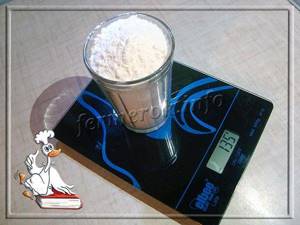
When pouring flour, it is worth checking whether voids have formed
The weight of a product is affected by many indicators, including humidity and density. Below we discuss in detail how many grams are in a faceted glass of various berries, cereals, nuts, liquids, etc.
Important!
A cut glass is always made of durable and thick glass. Such a reliable vessel, even when hitting the floor, does not always crack. This is one of the reasons for its popularity to this day.
Measurement table sugar, spices, nuts (content in grams)
| The product's name | Glass /250 ml/ (faceted glass to the brim) | Tablespoon | Tea spoon | 1 PC. |
| Sugar | 200 | 25 | 8 | — |
| Powdered sugar | 180 | 25 | 10 | — |
| Coarse salt | 360 | 30 | 10 | — |
| Fine salt | 400 | 31 | 11 | — |
| Cocoa powder | — | 15 | 5 | — |
| Ground coffee | — | 20 | 7 | — |
| Instant coffee | — | 15 | 5 | — |
| Honey | 350 | 30 | 10 | — |
| Tea | — | 10 | 3 | — |
| Mustard | — | 25 | 4 | |
| Lemon acid | — | 25 | 8 | — |
| Cinnamon | — | 20 | 8 | — |
| Gelatin in plates | — | — | — | 2.5 |
| Gelatin mass | — | — | ||
| Ground cloves | — | 15 | 3 | — |
| Carnation | — | 20 | 4 | 0.06 |
| Bay leaf | — | — | — | 0.2 |
| Ground black pepper | — | 11 | 5.5 | — |
| Allspice | — | — | 4.5 | — |
| Ground red pepper | — | — | 1.5 | — |
| Poppy | 155 | 18 | 5 | — |
| Raisin | 190 | 25 | 7 | — |
| Peanut | 175 | 25 | 8 | — |
| Walnuts | 100 | 15 | 8 | — |
| Hazelnut | 170 | 30 | 9 | — |
| Almond | 160 | 30 | 9 | — |
| Protein | — | 15 | 5 | — |
| Soda | — | 28 | 12 | — |
Foreign weight measures
If you like to cook according to foreign recipes, you may encounter unfamiliar weight measures, so this information will be useful in the kitchen. The American cup is our thin glass, that is, 250 g, and the English cup corresponds to 280 g. A pint is 470 g, an ounce is 30 g, and a quart “weighs” 950 g.
They say that the secret to culinary excellence is inspiration and precision, so the correct dosage of ingredients is half the battle. If you want to make your life easier and minimize complex arithmetic, buy a universal 500 ml measuring cup with divisions for liquid and bulk products. Delight your loved ones with delicious food and enjoy it yourself!
Culinary arithmetic
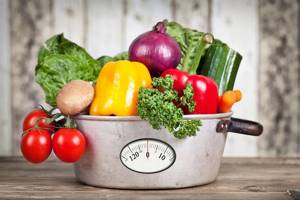
There is no need to keep dozens of numbers in your head to prepare a delicious dish and not go crazy with mathematical calculations. It is enough to have a table of weight measurements in spoons and glasses in the kitchen. If you see in a recipe an instruction to take half or a quarter cup of some product, such as sugar, then having a table, you can easily convert this amount into other measures. For example, a quarter of a faceted glass contains 45 g of sugar, which is 2 tbsp. l. sugar without a slide or 5.5 tsp. Interestingly, 1 tbsp. l. corresponds to 3 tsp, and a dessert spoon is 2 tsp. One thin glass holds 16 tbsp. l. liquid, thick and bulk products.

